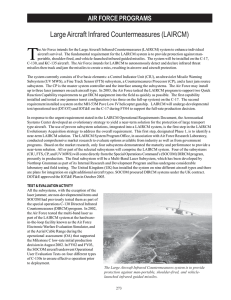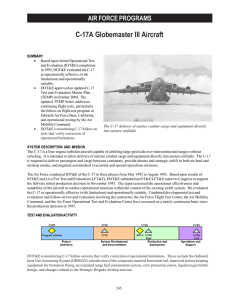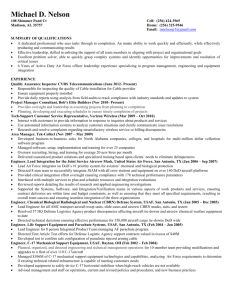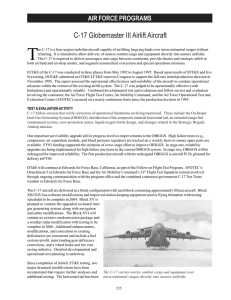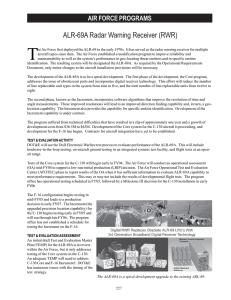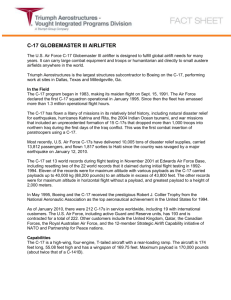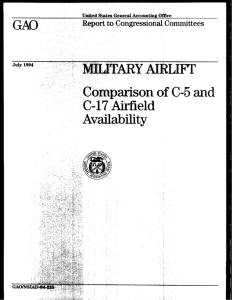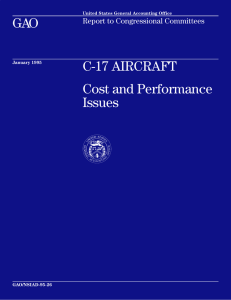Large Aircraft Infrared Countermeasures (LAIRCM) AIR FORCE PROGRAMS
advertisement
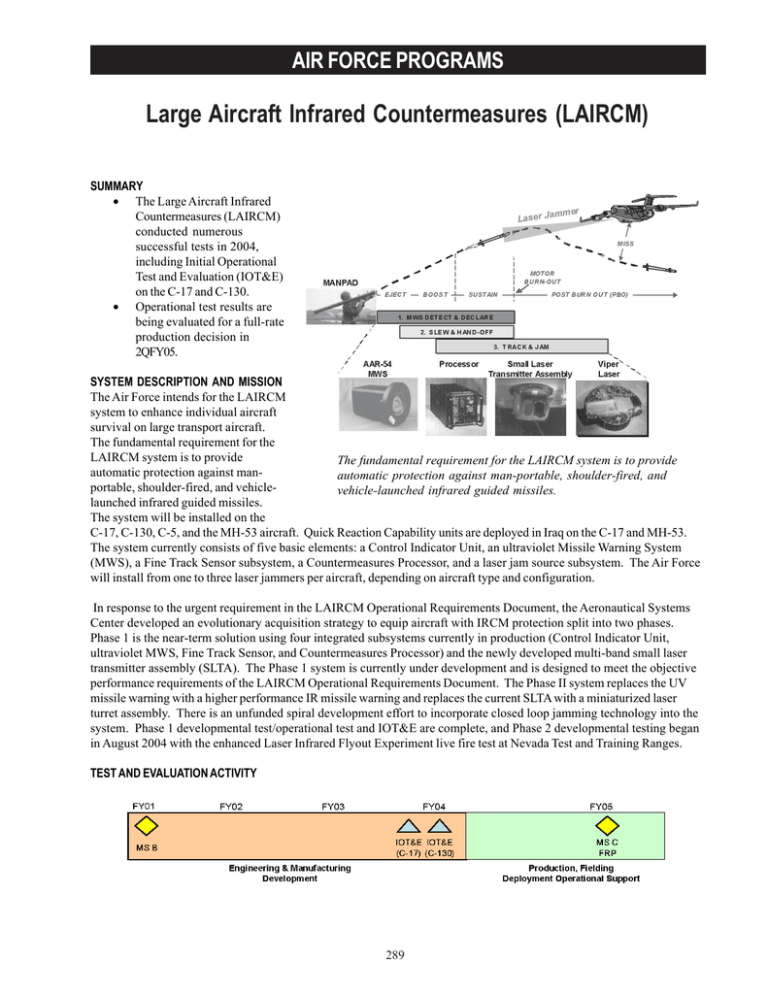
AIR FORCE PROGRAMS Large Aircraft Infrared Countermeasures (LAIRCM) SUMMARY • The Large Aircraft Infrared Countermeasures (LAIRCM) conducted numerous successful tests in 2004, including Initial Operational Test and Evaluation (IOT&E) on the C-17 and C-130. • Operational test results are being evaluated for a full-rate production decision in 2QFY05. SYSTEM DESCRIPTION AND MISSION The Air Force intends for the LAIRCM system to enhance individual aircraft survival on large transport aircraft. The fundamental requirement for the LAIRCM system is to provide The fundamental requirement for the LAIRCM system is to provide automatic protection against manautomatic protection against man-portable, shoulder-fired, and portable, shoulder-fired, and vehiclevehicle-launched infrared guided missiles. launched infrared guided missiles. The system will be installed on the C-17, C-130, C-5, and the MH-53 aircraft. Quick Reaction Capability units are deployed in Iraq on the C-17 and MH-53. The system currently consists of five basic elements: a Control Indicator Unit, an ultraviolet Missile Warning System (MWS), a Fine Track Sensor subsystem, a Countermeasures Processor, and a laser jam source subsystem. The Air Force will install from one to three laser jammers per aircraft, depending on aircraft type and configuration. In response to the urgent requirement in the LAIRCM Operational Requirements Document, the Aeronautical Systems Center developed an evolutionary acquisition strategy to equip aircraft with IRCM protection split into two phases. Phase 1 is the near-term solution using four integrated subsystems currently in production (Control Indicator Unit, ultraviolet MWS, Fine Track Sensor, and Countermeasures Processor) and the newly developed multi-band small laser transmitter assembly (SLTA). The Phase 1 system is currently under development and is designed to meet the objective performance requirements of the LAIRCM Operational Requirements Document. The Phase II system replaces the UV missile warning with a higher performance IR missile warning and replaces the current SLTA with a miniaturized laser turret assembly. There is an unfunded spiral development effort to incorporate closed loop jamming technology into the system. Phase 1 developmental test/operational test and IOT&E are complete, and Phase 2 developmental testing began in August 2004 with the enhanced Laser Infrared Flyout Experiment live fire test at Nevada Test and Training Ranges. TEST AND EVALUATION ACTIVITY 289 AIR FORCE PROGRAMS In FY04, the primary test and evaluation activities consisted of completing: • The C-17 test efforts including: the C-17 baseline test (October 2003 at Edwards Air Force Base), the C-17 regression test (December 2003 at Holloman Air Force Base), C-17 sled test (December 2003 at Holloman Air Force Base), and the C-17 IOT&E (February 2004 at Eglin Air Force Base). • The Super Multi-Role Electro-optical Simulation demonstration (December 2003 at Holloman Air Force Base). • The C-130 developmental test/operational test (February 2004 at Eglin Air Force Base). • The C-130 IOT&E (June 2004 at Eglin Air Force Base) to support a full-rate production decision in 2QFY05. All of the test and evaluation activities above, except the sled test, consisted of illuminating the C-17 or C-130 with a ground-based threat missile plume stimulator or simulator in order to produce a jamming response from the LAIRCM system. In most cases, infrared radiometers were collocated on the stimulator/simulator to record the jamming laser signal and to assess the power level and jamming technique fidelity. During three tests, the Air Force evaluated false alarm susceptibility and the robustness of the LAIRCM system on the C-17 and C-130 airframes. The sled test consisted of firing a missile down the high-speed test track at Holloman Air Force Base to test whether or not the LAIRCM system could detect, hand off, track, and jam a moving missile. A radiometer was mounted in the nose cone of the sled missile to record the jamming energy. In addition, false alarm sources were also present on the range to stress the MWS system and processor. The purpose of the Super Multi-Role Electro-optical Simulation demonstration was to demonstrate the validity that a missile simulator is the preferred method of testing over a missile stimulator. In September 2004, Phase 2 developmental testing of the Next Generation MWS and closed-loop laser system was conducted during the enhanced Laser Infrared Flyout Experiment test. In addition, other MWS systems were invited to gather MWS performance data - on their own system - at this same test in order to have a side-by-side comparison of MWS systems’ performance. TEST AND EVALUATION ASSESSMENT LAIRCM, using the majority of the components of the already fielded Directional Infrared Countermeasures (DIRCM) system, has been successful in testing to date. The previously accomplished DIRCM C-130 tests, the several successful live fire tests against the DIRCM system, and the extensive qualification and environmental tests that were performed on the DIRCM system, all substantially mitigated the usual risks associated with complex systems in development. However, these tests revealed several problems and the program office is working with the contractor to resolve them. The C-17 baseline test revealed flaws in the jamming sequence logic and in the flare-interaction logic of the system. The program office and the contractor developed new jamming sequence and flare logic to correct the problems. This new software was successfully tested and demonstrated at the C-17 regression test prior to the sled test. The sled test was only partially successful. The complex clutter environment severely stressed the system processor resulting in less than optimum performance. To address these problems, the contractor has undertaken a major effort to develop an upgraded system processor and new or better MWS algorithms to work efficiently in complex clutter environments. These upgrades will be available for testing in January 2005. The C-17 IOT&E, C-130 developmental test/operational test, and C-130 IOT&E have completed and the data are currently being reviewed and processed. Other than the issue with the operation of the system in a complex clutter environment, the only other major issue is the robustness of the automatic bore-sighting of the SLTA. The program office is pursuing a hardware upgrade to the SLTA. The LAIRCM program will seek a full-rate production decision in 2QFY05. Follow-on flight and/or regression testing will be needed to assess the performance of the hardware and software upgrades for the processor and the hardware upgrade for the SLTA. LAIRCM conducted an aggressive test program in FY04. DOT&E commends the program for recognizing performance problems early and taking immediate corrective action, including regression flight tests, to ensure that that the problems have been rectified. In addition to the performance problems, a number of suitability issues arose during the testing, which are being addressed. In particular, the reliability of the SLTAs needs to be improved to ensure adequate mission readiness when deployed. 290
